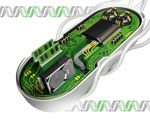Cellular Circuits with Memories
 Feb-16-13
MIT reaserachers have created genetic circuits in bacteria than can perform logic functions and remember the results, opening the door the possibility of programming stem cells into other cell types.
Feb-16-13
MIT reaserachers have created genetic circuits in bacteria than can perform logic functions and remember the results, opening the door the possibility of programming stem cells into other cell types.While current synthetic biologists use genetic parts to design circuits that perform a singular function, such as responding when particular chemical is detected, the team at MIT wanted to design a circuit that would be irreversibly altered by the stimulus, creating a sort of memory of the event. To accomplish this goal, they used recombinase enzymes, which cut and rearrange DNA sequences. These re-ordered sequences can then be encoded with a chosen cell’s DNA and passed on to other cells for generations, allowing the circuits to be used as long-term environmental sensors, biomanufacturing controls, or to program stem cells to transform into other cell types
According to Timothy Lu, “It’s really easy to swap things in and out. If you start off with a standard parts library, you can use a one-step reaction to assemble any kind of function that you want.”
More Info about this Invention:
[INHABITAT.COM][MIT]

Add Your Comment